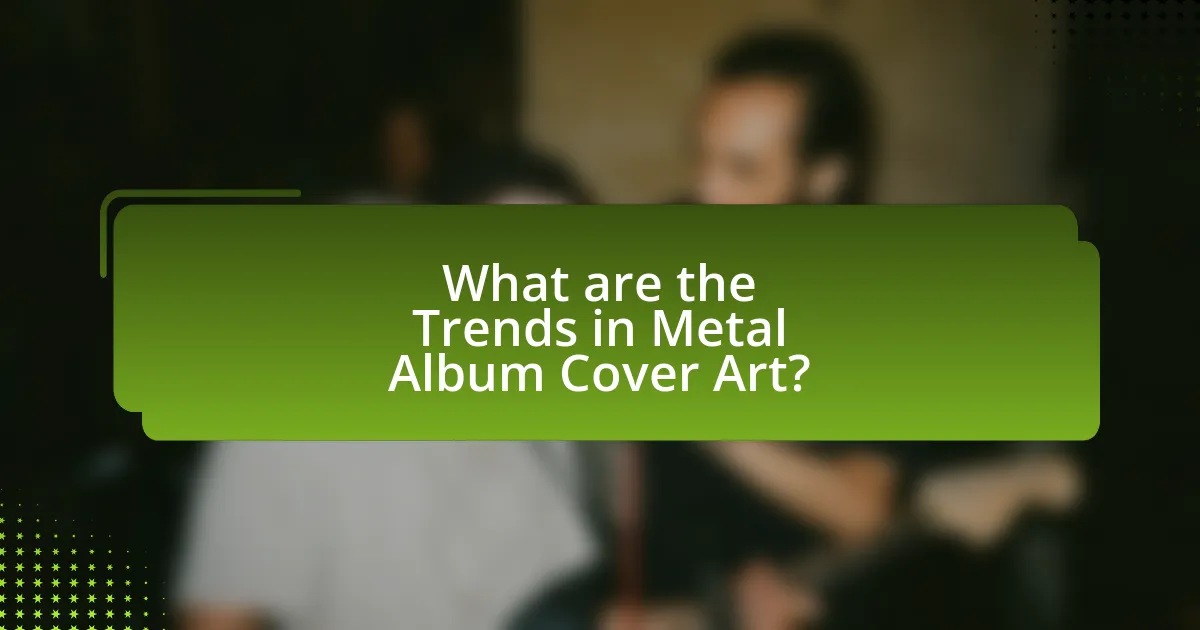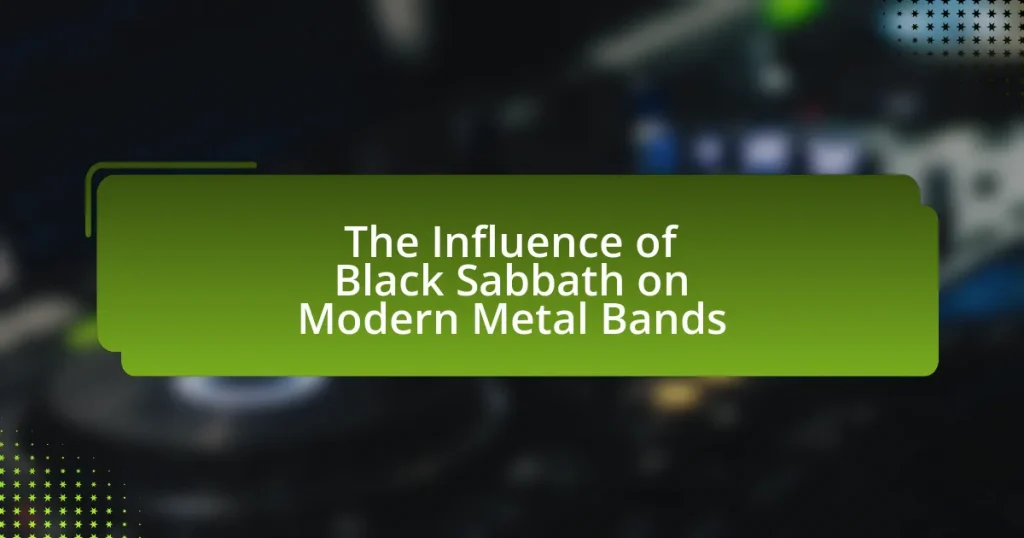Iconic album covers in metal music serve as crucial visual representations that enhance a band’s identity and appeal, with notable examples including Iron Maiden’s “The Number of the Beast” and Metallica’s “Master of Puppets.” These covers not only attract attention but also contribute to branding and marketing strategies, influencing fan loyalty and recognition. The article explores how visual elements, colors, and imagery shape perceptions of metal bands, the historical context that elevates certain covers to iconic status, and the impact of fan reactions on their legacy. Additionally, it examines trends in album cover art, the evolution of design practices, and best practices for creating effective album artwork in the contemporary metal scene.
![]()
What are Iconic Album Covers in Metal Music?
Iconic album covers in metal music are visually striking artworks that have become synonymous with the genre and its bands, often enhancing the band’s identity and appeal. Examples include Iron Maiden’s “The Number of the Beast,” featuring the iconic mascot Eddie, which has become a cultural symbol of heavy metal since its release in 1982. Another notable cover is Metallica’s “Master of Puppets,” which depicts a powerful image of control and manipulation, reinforcing the album’s themes. These covers not only attract attention but also contribute to the branding and marketing of the bands, making them memorable in the competitive music landscape.
How do album covers contribute to a band’s identity?
Album covers significantly contribute to a band’s identity by visually representing their music style, themes, and overall brand image. These covers serve as a first impression for potential listeners, encapsulating the essence of the band’s sound and aesthetic. For example, iconic album covers like Iron Maiden’s “The Number of the Beast” not only reflect the band’s heavy metal genre but also establish a recognizable visual identity that fans associate with their music. This visual branding can enhance fan loyalty and recognition, as seen in the consistent use of specific colors, imagery, and typography that align with the band’s thematic elements. Thus, album covers play a crucial role in shaping and communicating a band’s identity within the music industry.
What visual elements are commonly found in iconic metal album covers?
Iconic metal album covers commonly feature dark and aggressive visual elements, including skulls, mythical creatures, and apocalyptic landscapes. These elements serve to evoke themes of rebellion, fantasy, and horror, which resonate with the genre’s audience. For instance, the use of vivid colors and intricate artwork, as seen in covers like Iron Maiden’s “Eddie” or Metallica’s “Master of Puppets,” enhances the emotional impact and memorability of the album. Additionally, typography often incorporates sharp, angular fonts that reflect the intensity of the music, further solidifying the visual identity of the band.
How do colors and imagery influence perceptions of metal bands?
Colors and imagery significantly influence perceptions of metal bands by conveying emotions, themes, and identities associated with the genre. For instance, dark colors like black and deep red often evoke feelings of aggression, power, and rebellion, aligning with the heavy themes prevalent in metal music. Imagery such as skulls, demons, and fantasy elements further enhances this perception, creating a visual identity that resonates with fans. Research indicates that album covers featuring striking visuals and color schemes can increase consumer interest and engagement, as seen in iconic covers like Metallica’s “Master of Puppets,” which uses stark contrasts to reflect the album’s themes of control and manipulation. This visual branding not only attracts listeners but also solidifies the band’s image within the metal community.
Why are certain album covers considered iconic?
Certain album covers are considered iconic due to their unique visual representation that resonates with the music’s themes and cultural context. These covers often feature striking artwork, innovative design, or memorable imagery that captures the essence of the album, making them instantly recognizable. For example, Pink Floyd’s “The Dark Side of the Moon” cover, designed by Storm Thorgerson, is iconic because it symbolizes complex themes of life and mental health, while its prism design has become a cultural symbol. Additionally, album covers like Iron Maiden’s “The Number of the Beast” have become synonymous with the band’s identity, influencing metal culture and aesthetics. The combination of artistic creativity, cultural significance, and the ability to evoke emotional responses contributes to the iconic status of these album covers.
What historical context contributes to the iconic status of these covers?
The historical context that contributes to the iconic status of these covers includes the evolution of heavy metal music and its cultural significance during the late 20th century. In the 1970s and 1980s, heavy metal emerged as a distinct genre, characterized by its loud sound, rebellious themes, and elaborate artwork, which often reflected the band’s identity and message. Iconic covers, such as Iron Maiden’s “The Number of the Beast” and Metallica’s “Master of Puppets,” became symbols of the genre, resonating with fans and influencing the visual language of music marketing. The rise of album-oriented rock and the importance of visual aesthetics in music consumption during this period further solidified the role of album covers as essential elements of branding for metal bands.
How do fan reactions shape the legacy of album covers?
Fan reactions significantly shape the legacy of album covers by influencing public perception and cultural significance. When fans express strong opinions about an album cover, whether positive or negative, it can lead to increased visibility and discussion, thereby cementing the cover’s place in music history. For example, the controversial cover of Metallica’s “Load” sparked intense debate among fans, which ultimately contributed to its lasting impact and recognition within the metal genre. Additionally, fan-created content, such as artwork or memes inspired by album covers, can further enhance their legacy by keeping them relevant in contemporary discussions. This dynamic interaction between fans and album art underscores the importance of audience engagement in defining the historical significance of these visual elements in music.
![]()
How do Iconic Album Covers Impact Metal Band Branding?
Iconic album covers significantly enhance metal band branding by creating a visual identity that resonates with fans and communicates the band’s themes and style. These covers often feature striking imagery, which can evoke emotions and establish a connection with the audience, making the band more memorable. For instance, Iron Maiden’s “The Number of the Beast” cover, designed by Derek Riggs, has become synonymous with the band’s identity and has contributed to their lasting popularity. Research indicates that visual elements in music marketing can increase consumer engagement by up to 60%, demonstrating the effectiveness of iconic album art in shaping perceptions and driving brand loyalty within the metal genre.
What role does album artwork play in marketing metal bands?
Album artwork plays a crucial role in marketing metal bands by visually representing their identity and musical themes. This visual representation helps to attract potential listeners and create a memorable brand image. For instance, iconic album covers like Iron Maiden’s “The Number of the Beast” not only reflect the band’s aesthetic but also resonate with the themes of rebellion and fantasy that are prevalent in metal music. Research indicates that strong visual branding can increase consumer recognition and engagement, making album artwork a vital component in the overall marketing strategy of metal bands.
How do album covers attract new listeners?
Album covers attract new listeners by visually representing the music’s themes and emotions, creating an immediate connection. A striking or unique design can capture attention in a crowded market, prompting potential listeners to explore the music further. For instance, studies show that 70% of consumers make purchasing decisions based on visual appearance, highlighting the importance of album art in influencing listener choices. Additionally, iconic album covers often become part of a band’s identity, enhancing brand recognition and loyalty, which can lead to increased interest from new audiences.
What strategies do bands use to create memorable album art?
Bands create memorable album art by employing distinct visual themes, collaborating with skilled artists, and integrating symbolism that resonates with their music. For instance, metal bands often use dark, intricate imagery that reflects their lyrical content and musical style, enhancing the overall aesthetic experience. Collaborations with renowned artists, such as Storm Thorgerson for Pink Floyd, have historically resulted in iconic visuals that become synonymous with the band’s identity. Additionally, the use of color schemes and typography that align with the band’s branding further solidifies the artwork’s memorability, as seen in the use of bold, contrasting colors in Metallica’s “Master of Puppets.” These strategies not only capture attention but also create a lasting impression that contributes to the band’s legacy in the music industry.
Why is consistency in album cover design important for branding?
Consistency in album cover design is crucial for branding because it establishes a recognizable visual identity that resonates with fans. This visual coherence helps to create a strong association between the music and the imagery, reinforcing the band’s unique style and message. For example, bands like Iron Maiden have maintained a consistent aesthetic through their iconic mascot, Eddie, which has become synonymous with their brand. This consistency not only aids in brand recall but also fosters loyalty among fans, as they come to expect a certain visual experience that aligns with the band’s musical evolution.
How does a cohesive visual identity enhance a band’s image?
A cohesive visual identity enhances a band’s image by creating a recognizable and unified aesthetic that resonates with fans. This consistency across album covers, merchandise, and promotional materials helps establish a strong brand presence, making it easier for audiences to identify and connect with the band. For example, Metallica’s iconic logo and album artwork have become synonymous with their music, reinforcing their brand identity and attracting a loyal fanbase. Research indicates that visual branding can significantly influence consumer perception and loyalty, as seen in studies showing that consistent branding can increase revenue by up to 23%.
What are the risks of deviating from established visual themes?
Deviating from established visual themes poses significant risks to brand identity and audience perception. When metal bands alter their visual themes, they may confuse existing fans and alienate potential new listeners, leading to a dilution of brand recognition. For instance, a study by the Journal of Marketing Research indicates that consistent branding can enhance consumer loyalty by up to 23%. Additionally, inconsistency in visual themes can result in a loss of credibility, as fans may perceive the band as inauthentic or lacking a clear artistic direction. This can ultimately impact sales and streaming numbers, as visual coherence is crucial in the highly competitive music industry.

What are the Trends in Metal Album Cover Art?
Trends in metal album cover art include a focus on vivid, surreal imagery, often featuring themes of fantasy, horror, and mythology. This trend reflects the genre’s roots in escapism and rebellion, with artists frequently employing bold colors and intricate details to capture attention. For instance, the use of digital art has surged, allowing for more complex designs that were previously difficult to achieve. Additionally, there is a growing trend towards minimalism in some subgenres, where simplicity and stark imagery convey powerful messages. The evolution of these trends can be seen in iconic covers like Iron Maiden’s “The Number of the Beast,” which combines detailed artwork with thematic depth, influencing both band branding and fan engagement.
How have design trends evolved in metal album covers over the decades?
Design trends in metal album covers have evolved significantly over the decades, reflecting changes in artistic styles, cultural influences, and technological advancements. In the 1970s, early metal album covers often featured fantasy art and mythical themes, exemplified by bands like Black Sabbath and Led Zeppelin, which set a precedent for dramatic imagery. The 1980s introduced a more aggressive aesthetic with the rise of thrash and death metal, showcasing darker themes, grotesque imagery, and vibrant colors, as seen in covers by Metallica and Slayer.
By the 1990s, the trend shifted towards minimalism and abstract designs, influenced by grunge and alternative rock, with bands like Pantera adopting simpler, more direct visuals. The 2000s saw a resurgence of detailed artwork, often incorporating digital techniques, with bands like Opeth and Nightwish blending traditional and modern styles. Currently, metal album covers continue to explore diverse artistic expressions, including surrealism and mixed media, reflecting broader cultural trends and the influence of social media on visual branding. This evolution illustrates how metal album covers serve not only as artistic statements but also as vital components of band identity and marketing.
What influences contemporary metal album cover designs?
Contemporary metal album cover designs are influenced by a combination of artistic trends, cultural themes, and the genre’s historical context. Artists often draw inspiration from surrealism, horror, and fantasy, reflecting the music’s intensity and emotional depth. Additionally, the rise of digital art has allowed for more intricate and visually striking designs, enabling artists to experiment with new techniques and styles. The historical significance of iconic metal covers, such as those by Iron Maiden and Metallica, also shapes current designs, as new artists seek to evoke similar reactions and connections with their audience. This blend of artistic innovation and homage to the past creates a dynamic landscape for contemporary metal album art.
How do technological advancements impact album artwork creation?
Technological advancements significantly enhance album artwork creation by providing artists with innovative tools and techniques. Digital software allows for intricate designs, enabling artists to manipulate images with precision and create complex visual narratives that were previously difficult to achieve. For instance, programs like Adobe Photoshop and Illustrator facilitate high-resolution graphics and detailed illustrations, which are essential for capturing the attention of audiences in the competitive music market. Additionally, advancements in printing technology, such as high-quality digital printing, ensure that album covers can be produced with vibrant colors and sharp details, further elevating the visual impact. The integration of augmented reality (AR) and interactive elements in album artwork also engages fans in new ways, creating immersive experiences that enhance the overall branding of metal bands.
What are the most notable examples of recent iconic album covers?
Recent notable examples of iconic album covers include “Fear Inoculum” by Tool, “The Stage” by Avenged Sevenfold, and “Death Atlas” by Cattle Decapitation. “Fear Inoculum,” released in 2019, features a striking, intricate design that reflects the band’s progressive metal style and has been widely praised for its artistic depth. “The Stage,” released in 2016, showcases a powerful visual narrative that aligns with the album’s themes of existentialism and has become a defining image for Avenged Sevenfold. “Death Atlas,” released in 2019, presents a haunting and evocative cover that captures the essence of the band’s brutal sound and lyrical content. These covers have not only contributed to the visual identity of their respective bands but have also influenced the broader landscape of metal album art.
How do these recent covers compare to classic designs?
Recent album covers often prioritize modern aesthetics and digital techniques, contrasting with classic designs that relied on hand-drawn artwork and physical media. Classic designs, such as Iron Maiden’s “The Number of the Beast,” utilized intricate illustrations and tangible textures, creating a distinct visual identity that resonated with fans. In contrast, recent covers frequently employ digital manipulation and minimalist styles, reflecting contemporary trends in graphic design. This shift can be seen in albums like Ghost’s “Impera,” which combines modern imagery with thematic elements, yet lacks the tactile quality of earlier works. The evolution in design reflects broader changes in technology and audience preferences, impacting how metal bands brand themselves today.
What messages do these new covers convey about the current metal scene?
New album covers in the metal scene convey a message of evolution and diversity within the genre. These covers often reflect contemporary themes such as social issues, personal struggles, and technological advancements, showcasing how metal continues to adapt and resonate with current audiences. For instance, recent artwork frequently incorporates modern graphic design techniques and vibrant colors, contrasting with the traditional dark and monochromatic styles of earlier metal albums. This shift indicates a broader acceptance of varied influences and a willingness to explore new artistic expressions, highlighting the genre’s ongoing relevance and ability to attract a wider fan base.
What best practices should bands follow for effective album cover design?
Bands should prioritize originality and visual storytelling in their album cover design to effectively convey their music’s essence. Originality ensures that the cover stands out in a saturated market, while visual storytelling connects emotionally with the audience, reflecting the themes and mood of the album. Research indicates that iconic album covers, such as Iron Maiden’s “The Number of the Beast,” utilize striking imagery and cohesive branding to enhance recognition and fan engagement. Additionally, bands should consider color schemes and typography that align with their genre, as these elements significantly influence audience perception and brand identity.

